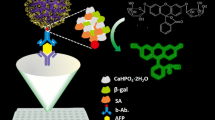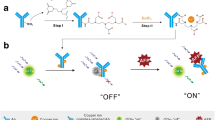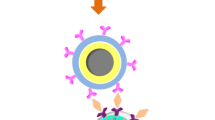Abstract
Magnetofluorescent nanocomposites with optimal magnetic and fluorescent properties were prepared and characterized by combining magnetic nanoparticles (iron oxide@polymethyl methacrylate) with fluorescent nanoparticles (rhodamine 6G@mSiO2). Experimental parameters were optimized to produce nanocomposites with high magnetic susceptibility and fluorescence intensity. The detection of a model biomarker (alpha-fetoprotein) was used to demonstrate the feasibility of applying the magnetofluorescent nanocomposites combined with quantum dots and using magnetic fluorescence-linked immunoassay. The magnetofluorescent nanocomposites enable efficient mixing, fast re-concentration, and nanoparticle quantization for optimal reactions. Biofunctional quantum dots were used to confirm the alpha-fetoprotein (AFP) content in sandwich immunoassay after mixing and washing. The analysis time was only one third that required in ELISA. The detection limit was 0.2 pg mL−1, and the linear range was 0.68 pg mL−1–6.8 ng mL−1. This detection limit is lower, and the linear range is wider than those of ELISA and other methods. The measurements made using the proposed method differed by less than 13% from those obtained using ELISA for four AFP concentrations (0.03, 0.15, 0.75, and 3.75 ng mL−1). The proposed method has a considerable potential for biomarker detection in various analytical and biomedical applications.

Magnetofluorescent nanocomposites combined with fluorescent quantum dots were used in magnetic fluorescence-linked immunoassay.




Similar content being viewed by others
References
Reddy LH, Arias JL, Nicolas J, Couvreur P. Magnetic nanoparticles: design and characterization, toxicity and biocompatibility, pharmaceutical and biomedical applications. Chem Rev. 2012;112:5818–78.
Tsai HY, Chan JR, Li YC, Cheng FC, Fuh CB. Determination of hepatitis B surface antigen using magnetic immunoassays in a thin channel. Biosens Bioelectron. 2010;25:2701–5.
Tsai HY, Hsieh YC, Chan JR, Su YM, Chang YC, Fuh CB. Effects of particle characteristics on magnetic immunoassay in a thin channel. Biosens Bioelectron. 2011;28:38–43.
Qiu Z, Shu J, He Y, Lin Z, Zhang K, Lv S, et al. CdTe/CdSe quantumdot-based fluorescent aptasensor with hemin/G-quadruplex DNzyme for sensitive detection of lysozyme using rolling circle amplification and strand hybridization. Biosens Bioelectron. 2017;87:18–24.
Lin Y, Zhou Q, Tang D, Niessner R, Knopp D. Signal-on photoelectrochemical immunoassay for aflatoxin B1 based on enzymatic product-etching MnO2 nanosheets for dissociation of carbon dots. Anal Chem. 2017;89:5637–45.
Qiu Z, Shu J, Tang D. Bioresponsive release system for visual fluorescence detection of carcinoembryonic antigen from mesoporous silica nanocontainers mediated optical color on quantum dot-enzyme-impregnated paper. Anal Chem. 2017;89:5152–60.
Wang G, Zhang X, Liu Y, Hu Z, Mei X, Uvda K. Magneto-fluorescent nanoparticles with high intensity NIR emission, T1- and T2-weighted MR for multimodal specific tumor imaging. J Mater Chem B. 2015;3:3072–80.
Chen M, He Y, Chen X, Wang J. Quantum dots conjugated with Fe3O4-filled carbon nanotubes for cancer-targeted maging and magnetically guided drug delivery. Langmuir. 2012;28:16469–76.
Sathe R, Agrawal A, Nie S. Mesoporous silica beads embedded with semiconductor quantum dots and iron oxide nanocrystals: dual-function microcarriers for optical encoding and magnetic separation. Anal Chem. 2006;78:5627–32.
Wu J, Fu Z, Yan F, Ju H. Biomedical and clinical applications of immunoassays and immunosensors for tumor markers. Trends Anal Chem. 2007;26:679–88.
Boonham N, Kreuze J, Winter S, van der Vlugt R, Bergerrvoet J, Tomlinson J, et al. Methods in virus diagnostics: from ELISA to next generation sequencing. Virus Res. 2014;186:20–31.
Lequin RM. Enzyme immunoassay (EIA)/enzyme-linked immunosorbent assay (ELISA). Clin Chem. 2005;51:2415–8.
Tsai HY, Chuang MJ, Chou BC, Yang SF, Fuh CB. Quantitative improvement of magnetic immunoassays in thin channels using magnetofluorescent nanocomposites. Sensors Actuators B Chem. 2016;223:834–8.
Tang D, Su B, Tang J, Ren J, Chen G. Nanoparticle-based sandwich electrochemical immunoassay for carbohydrate antigen 125 with signal enhancement using enzyme-coated nanometer-sized enzyme-doped silica beads. Anal Chem. 2010;82:1527–34.
Gao J, Zhang W, Huang P, Zhang B, Zhang X, Xu B. Intracellular spatial control of fluorescent magnetic nanoparticles. J Am Chem Soc. 2008;130:3710–1.
Wang F, Chen X, Zhao Z, Tang S, Huang X, Lin C, et al. Synthesis of magnetic, fluorescent and mesoporous core-shell-structured nanoparticles for imaging, targeting and photodynamic therapy. J Mater Chem. 2011;21:11244–52.
Yi DK, Selvan ST, Lee SS, Papaefthymiou GC, Kunolaliya D, Ying JY. Silica-coated nanocomposites of magnetic nanoparticles and quantum dots. J Am Chem Soc. 2005;127:4990–1.
Huang X, Ren J. Gold nanoparticles based chemiluminescent resonance energy transfer for immunoassay of alpha fetoprotein cancer marker. Anal Chim Acta. 2011;686:115–20.
Qi T, Liao J, Li Y, Peng J, Li W, Chu B, et al. Label-free alpha fetoprotein immunosensor established by the facile synthesis of a palladium-graphene nanocomposite. Biosens Bioelectron. 2014;61:245–50.
Qi H, Ling C, Ma Q, Gao Q, Zhang C. Sensitive electrochemical immunosensor array for the simultaneous detection of multiple tumor markers. Analyst. 2012;137:393–9.
Zhang J, Wang S, Liu K, Wei Y, Wang X, Duan Y. Novel signal-enhancing immunoassay for ultrasensitive biomarker detection based on laser-induced fluorescence. Anal Chem. 2015;87:2959–65.
Acknowledgments
We thank Mr. S. S. Chuang, Mr. Lokesh Bettad, and Ms. Y. S. Lu for technical assistance.
Funding
This work was supported by the Ministry of Science and Technology in Taiwan (Grant MOST-104-2119-M-260-003).
Author information
Authors and Affiliations
Corresponding author
Ethics declarations
Conflict of interest
The authors declare that they have no conflict of interest.
Electronic supplementary material
ESM 1
(PDF 1.16 mb).
Rights and permissions
About this article
Cite this article
Tsai, H.Y., Li, S.Y. & Fuh, C.B. Magnetofluorescent nanocomposites and quantum dots used for optimal application in magnetic fluorescence-linked immunoassay. Anal Bioanal Chem 410, 1923–1929 (2018). https://doi.org/10.1007/s00216-018-0856-6
Received:
Revised:
Accepted:
Published:
Issue Date:
DOI: https://doi.org/10.1007/s00216-018-0856-6




